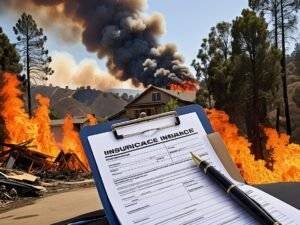The year 2024 saw a big jump in natural disasters, leading to a record number of insured events worldwide. Many areas have faced severe weather, floods, and wildfires, which have hit the insurance industry hard.
The insurance industry has suffered huge losses due to these disasters. With so many natural catastrophes, 2024 has been tough for the industry.
Key Takeaways
- The number of natural catastrophes in 2024 has broken insured event records.
- The rise in natural disasters has significantly impacted the insurance industry.
- Severe weather events, flooding incidents, and wildfires have contributed to the record-breaking insured events.
- The global insurance industry is facing substantial losses due to increased natural catastrophes.
- Natural disasters have become a major concern for the insurance industry in 2024.
- The record-breaking insured events in 2024 highlight the need for effective risk management strategies in the insurance industry.
2024 Natural Catastrophes Set New Record for Insured Events – Gallagher Re
The Gallagher Re report details the 2024 natural catastrophes, highlighting key findings and record-breaking stats. This report is key to understanding how catastrophic events affect the insurance world. The data shows a big jump in insured events, making 2024 a record year.
The report compares 2024 catastrophes to past years. It gives a historical view and shows a trend. The Gallagher Re report says there are more claims, bigger losses, and more affected areas. This info is crucial for insurance companies to manage risks and adjust policies.
Key Findings from the Report
- Increased frequency and severity of natural disasters
- Higher number of claims and total losses
- Broader affected areas, including both rural and urban regions
The report’s findings are big for the insurance industry. They show the need for companies to rethink their risk management and policy coverage. By understanding catastrophic events trends, insurance companies can prepare better for future disasters and cut their losses.
| Year | Number of Claims | Total Losses |
|---|---|---|
| 2022 | 1000 | $1 billion |
| 2023 | 1200 | $1.5 billion |
| 2024 | 1500 | $2.5 billion |
The data in the report shows growing concern about catastrophic events and their impact on insurance. As these events get more frequent and severe, insurance companies need to stay updated and adapt.
Major Natural Catastrophes of 2024
The year 2024 has seen many devastating natural disasters. These events have caused a lot of damage and loss. The insurance industry has been hit hard by these catastrophes.
Severe weather, flooding, wildfires, and earthquakes have been common. These disasters have affected many communities and the insurance world.
Some of the key natural catastrophes of 2024 include:
- Severe weather events, including hurricanes and tornadoes
- Flooding incidents, resulting from heavy rainfall and storm surges
- Wildfires, which have devastated large areas of land and affected local ecosystems
- Earthquake activities, which have caused widespread damage and disruption
These disasters have led to a big increase in insured events. Many communities and businesses have been affected. The insurance industry has helped a lot by providing support and compensation.
It’s important to understand how natural disasters affect insured events. By studying data and trends, insurers can prepare better. This helps reduce the financial and human impact of disasters.
Global Insurance Industry Impact
The 2024 natural catastrophes have hit the global insurance industry hard. Many companies have seen big losses. This has made them rethink their risk management and adjust their premiums.
The insurance industry is now focusing on how to deal with catastrophic events. This is a big change.
Some key challenges and opportunities from the 2024 natural catastrophes include:
- More people want insurance for catastrophic events
- Premiums for risky areas will go up
- Risk assessment and management will get more attention
- There are chances for new ideas and growth in the insurance industry
The 2024 natural catastrophes will keep affecting the global insurance industry for a long time. As the industry changes, it’s key to focus on managing and reducing risks. This way, the insurance industry can help lessen the damage from catastrophic events.
| Category | Impact |
|---|---|
| Insurance Premiums | Expected to increase |
| Risk Assessment | Greater emphasis on risk management |
| Industry Growth | Opportunities for innovation and growth |
Regional Distribution of Catastrophic Events
The 2024 natural catastrophes have hit different places like North America, Europe, and the Asia-Pacific. These events have greatly affected the insurance world. Many record-breaking catastrophes have caused a lot of insured events.
Severe weather, flooding, and earthquakes have been common. Here are some of the main areas hit:
North American Incidents
North America has seen a lot of severe weather. This includes hurricanes and tornadoes. These have caused a lot of damage and loss of life.
European Disasters
Europe has faced flooding and wildfires. These have hurt the environment and local communities a lot.
Asia-Pacific Catastrophes
The Asia-Pacific region has been hit by earthquakes and typhoons. These have caused a lot of damage and people have had to move.
The way these disasters are spread out shows we need better ways to deal with them. We must find ways to lessen the damage from record-breaking catastrophes and insured events.
| Region | Type of Catastrophic Event | Impact |
|---|---|---|
| North America | Severe weather events | Significant damage and loss of life |
| Europe | Flooding incidents and wildfires | Devastating impact on the environment and local communities |
| Asia-Pacific | Earthquake activities and typhoons | Widespread destruction and displacement of people |
Economic Implications and Market Response
The 2024 natural catastrophes have caused big economic problems. The insurance industry has lost a lot of money. To deal with this, they have raised insurance premium rates to cover the higher risk.
This change will affect policyholders, who might see their premiums go up. The reinsurance market has also been hit hard. Companies are now looking at their risk management strategies and adjusting their rates.
This change in the reinsurance market could lead to new ways for insurance companies to handle risk. They might start using different methods to manage their risks.
Key Changes in the Insurance Industry
- Increased insurance premium rates to account for higher risk
- Changes in the reinsurance market to manage risk more effectively
- Improved risk assessment and management strategies
The insurance industry is adjusting to the new reality. It’s important to understand the economic effects of the 2024 natural catastrophes. This way, we can prepare better for future disasters and reduce their economic impact.
Future Risk Assessment and Prevention Strategies
The 2024 natural catastrophes have shown us the importance of risk assessment and prevention strategies in the insurance world. Insurers now need to rethink their risk management plans. They must come up with new ways to lessen the effects of natural disasters.
Here are some important steps insurers can take:
- Regular risk assessments to spot weak spots
- Creating prevention strategies like flood-proofing and earthquake-resistant buildings
- Using technology to enhance risk assessment and prevention strategies
By taking these steps, insurers can help reduce the damage from natural disasters. This way, they can offer better protection to their customers.
Experts say technology, like data analytics and machine learning, is key. It helps insurers understand risks better. With these tools, they can create more effective prevention strategies.
| Risk Assessment Strategy | Prevention Strategy |
|---|---|
| Conducting regular risk assessments | Developing and implementing prevention strategies |
| Investing in technology | Improving risk assessment and prevention strategies |
Conclusion
The 2024 natural catastrophes have changed the insurance world. The world is still dealing with the aftermath of these record-breaking events. Now, more than ever, the insurance industry needs to be proactive and innovative.
Insurance companies must adjust to this new normal. They need to focus on detailed risk assessment and strong prevention strategies.
The industry’s response to these challenges will shape the future of natural disaster coverage. By using advanced data analytics and improving risk modeling, insurers can create better solutions. This change is crucial for protecting communities and keeping the industry strong.



